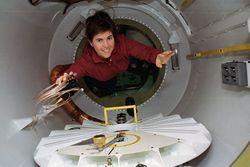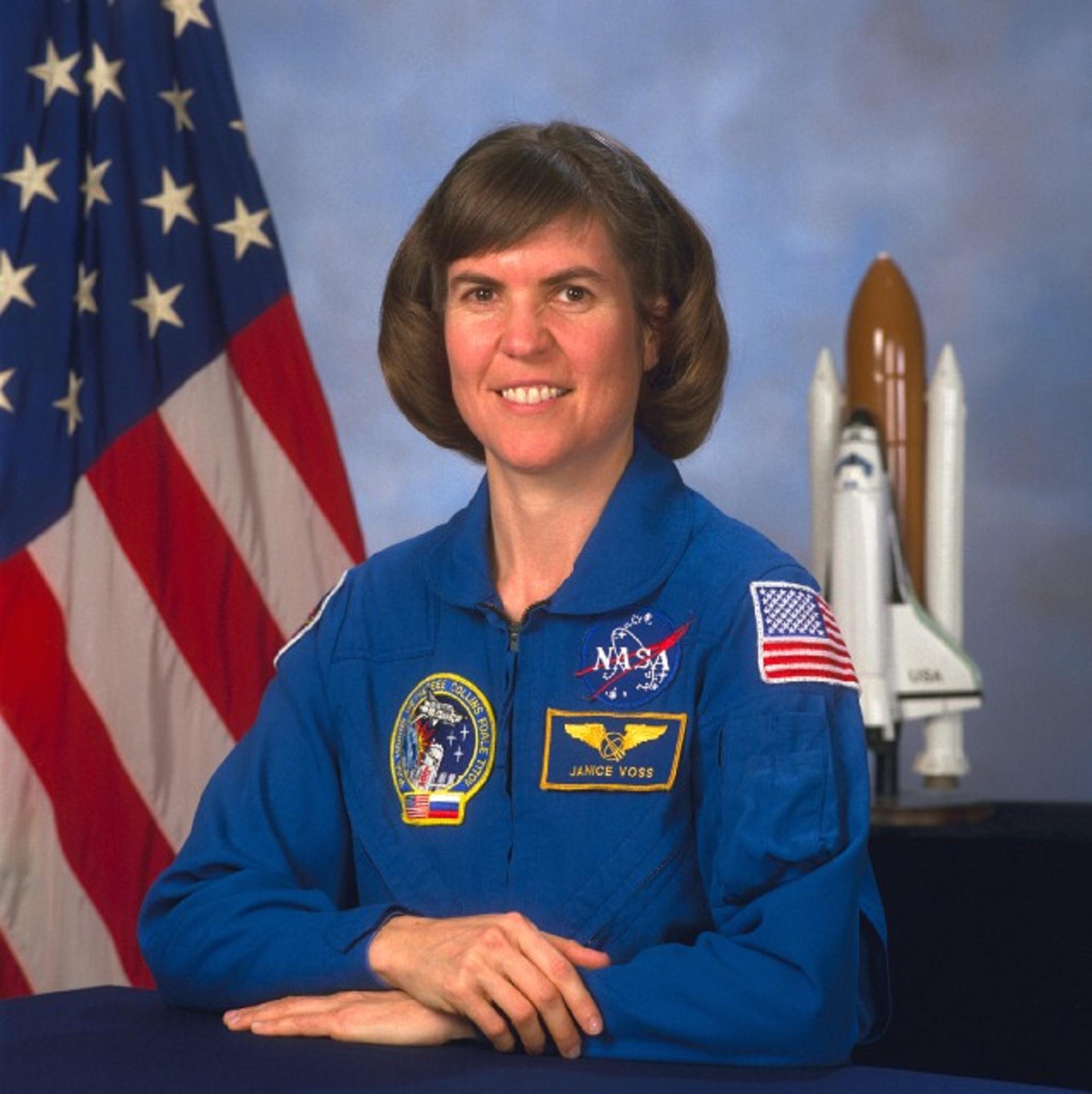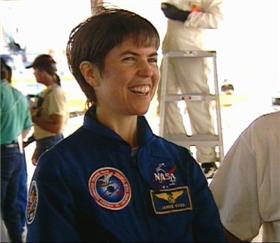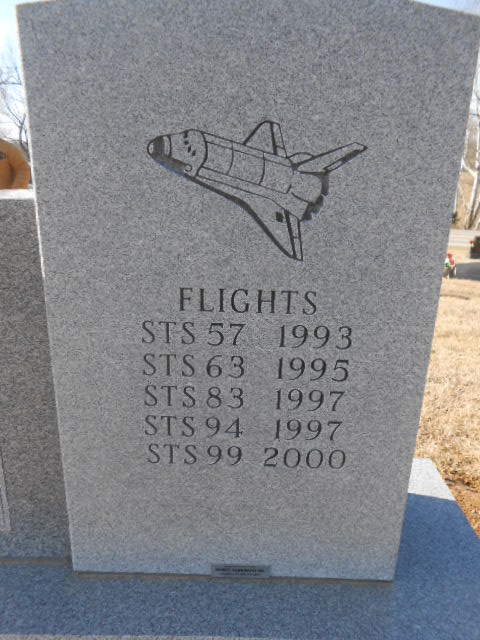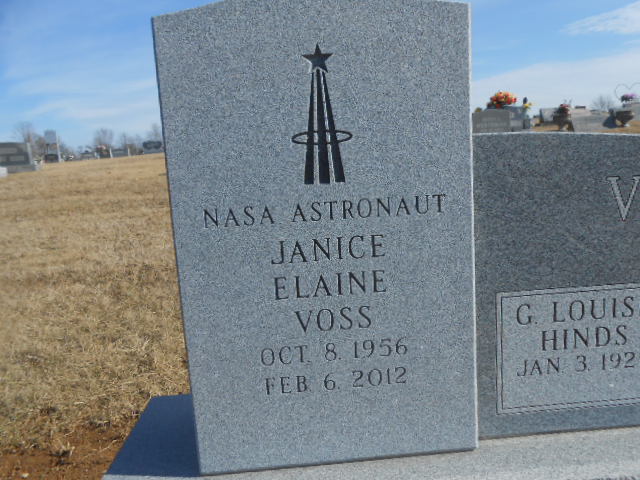She graduated from Minnechaug Regional High School, Wilbraham, Massachusetts, in 1972; received a bachelor of science degree in engineering science from Purdue University in 1975, a master of science degree in electrical engineering and a doctorate in aeronautics/astronautics from the Massachusetts Institute of Technology in 1977 and 1987, respectively. From 1973 to 1975 she took correspondence courses at the University of Oklahoma. She also did some graduate work in space physics at Rice University in 1977 and 1978.
Chosen by NASA for the astronaut corps in January 1990, Voss served as mission specialist on five space shuttle missions, including the only repeat flight in the shuttle program's 30-year history. She flew with the first commercial laboratory, rendezvoused with Russia's Mir space station and helped create the most complete digital topographic map of the Earth.
Of her five shuttle flights, the first and the last missions were on board the Endeavor. As a member of the STS-57 crew in June 1993, she helped conduct biomedical and material science experiments in the first commercially-developed Spacehab module.
In February 2000 Voss again launched on Endeavour, this time for NASA's Shuttle Radar Topography Mission. After deploying a nearly 200-foot mast, Voss and her crewmates worked around the clock in two shifts to map more than 47 million square-miles of the Earth's land surface.
Voss' second flight to space marked the first time a space shuttle came within the vicinity of Russia's space station Mir. Flying on the shuttle Discovery, Voss and her STS-63 crewmates — including Eileen Collins, the first woman to pilot a U.S. spacecraft — rendezvoused with the Russian outpost to verify flight techniques, communications, and navigation and sensor aids.
Voss' two other spaceflights, STS-83 and STS-94, were the only time in the shuttle program's history that an entire crew was launched twice to achieve the same mission. The crew's first attempt began with a liftoff on Columbia on April 4, 1997. Three days into the mission however, it was aborted, and the crew members returned to Earth. Three months later with Columbia back in working order, Voss and her six STS-83 crewmates launched again, this time as the STS-94 crew.
Four years after returning to Earth for a final time, Voss transferred from Johnson Space Center in Houston, Texas, to NASA's Ames Research Center at Moffett Field, Calif., where she headed the science program for the agency's Kepler space observatory. Voss left Ames in 2007.
A multiple recipient of NASA's Space Flight Medal, Voss donated her personal papers, documenting her spaceflight career to Purdue Libraries' division of archives and special collections in 2009. "Knowing that someone else got from here to there brightened many of my days at Purdue," Voss said at the time. "Maybe my papers will help someone else feel that they aren't that different from me. If I can do it, then so can they," Voss said.
SPECIAL HONORS: NASA Space Flight Medals (1993, 1995, 1997, 2000); Zonta Amelia Earhart Fellowship (1982); Howard Hughes Fellowship (1981); National Science Foundation Fellowship (1976).
She graduated from Minnechaug Regional High School, Wilbraham, Massachusetts, in 1972; received a bachelor of science degree in engineering science from Purdue University in 1975, a master of science degree in electrical engineering and a doctorate in aeronautics/astronautics from the Massachusetts Institute of Technology in 1977 and 1987, respectively. From 1973 to 1975 she took correspondence courses at the University of Oklahoma. She also did some graduate work in space physics at Rice University in 1977 and 1978.
Chosen by NASA for the astronaut corps in January 1990, Voss served as mission specialist on five space shuttle missions, including the only repeat flight in the shuttle program's 30-year history. She flew with the first commercial laboratory, rendezvoused with Russia's Mir space station and helped create the most complete digital topographic map of the Earth.
Of her five shuttle flights, the first and the last missions were on board the Endeavor. As a member of the STS-57 crew in June 1993, she helped conduct biomedical and material science experiments in the first commercially-developed Spacehab module.
In February 2000 Voss again launched on Endeavour, this time for NASA's Shuttle Radar Topography Mission. After deploying a nearly 200-foot mast, Voss and her crewmates worked around the clock in two shifts to map more than 47 million square-miles of the Earth's land surface.
Voss' second flight to space marked the first time a space shuttle came within the vicinity of Russia's space station Mir. Flying on the shuttle Discovery, Voss and her STS-63 crewmates — including Eileen Collins, the first woman to pilot a U.S. spacecraft — rendezvoused with the Russian outpost to verify flight techniques, communications, and navigation and sensor aids.
Voss' two other spaceflights, STS-83 and STS-94, were the only time in the shuttle program's history that an entire crew was launched twice to achieve the same mission. The crew's first attempt began with a liftoff on Columbia on April 4, 1997. Three days into the mission however, it was aborted, and the crew members returned to Earth. Three months later with Columbia back in working order, Voss and her six STS-83 crewmates launched again, this time as the STS-94 crew.
Four years after returning to Earth for a final time, Voss transferred from Johnson Space Center in Houston, Texas, to NASA's Ames Research Center at Moffett Field, Calif., where she headed the science program for the agency's Kepler space observatory. Voss left Ames in 2007.
A multiple recipient of NASA's Space Flight Medal, Voss donated her personal papers, documenting her spaceflight career to Purdue Libraries' division of archives and special collections in 2009. "Knowing that someone else got from here to there brightened many of my days at Purdue," Voss said at the time. "Maybe my papers will help someone else feel that they aren't that different from me. If I can do it, then so can they," Voss said.
SPECIAL HONORS: NASA Space Flight Medals (1993, 1995, 1997, 2000); Zonta Amelia Earhart Fellowship (1982); Howard Hughes Fellowship (1981); National Science Foundation Fellowship (1976).
Bio by: rhondajo
Advertisement
